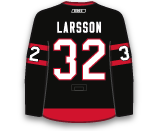
NHL Scratches & Line Changes



Vrana had six goals, five assists, four PIMs and a -2 plus/minus through 17 games played with Grand Rapids (AHL) and was called up Tuesday for the second time this season but will be a healthy scratch Wednesday vs. Edmonton. Vrana had a goal and two points in two games prior to entering the NHL and NHLPA's Player Assistance Program on October 19th.

Leason has four goals, three assists, 37 SOG, six PIMs and a -19 plus/minus through 43 games played this season but will be a healthy scratch Wednesday as the Ducks take on the Sabres. He will be replaced by Maxime Comtois in the lineup.

Comtois was a healthy scratch for the Ducks' previous game but will draw back into the lineup Wednesday as they take on Buffalo. The 24-year-old has five goals, four assists, 62 SOG, 70 PIMs and a -13 plus/minus through 42 games this season.

Goligoski was a healthy scratch for the Wilds' previous two games but will draw back into the lineup Wednesday vs. Colorado. The 21-year-old has a goal, two assists, 33 SOG, and a -3 plus/minus through 21 games this season.

Addison has three goals, 24 assists, 66 SOG, 20 PIMs and a -18 plus/minus through 52 games this season but will now hit the press box as he is replaced by Alex Goligoski Wednesday vs. Colorado. It is Addison's second healthy scratch this season as he looks to improve his defensive zone play.


Labanc has surprisingly been a healthy scratch for the Sharks' previous four games but will draw back into the lineup Tuesday as they take on the Washington Capitals. The 27-year-old right winger has 10 goals, 15 assists, 83 SOG, 22 PIMs and a -3 plus/minus through 45 games played.

Perbix has four goals, 11 assists, 70 SOG, 14 PIMs and a +11 plus/minus through 42 games this season but will be a healthy scratch Tuesday vs. Carolina.

Larsson last suited up for the Senators on November 21st but will find himself back in their lineup Tuesday as they take on the New York Islanders. Through his three games played this season, he has yet to pick up a point but has four PIMs and is a -1 plus/minus.

Wideman has been a healthy scratch for the Canadiens' previous two games but will draw back into the lineup Tuesday as they take on the Chicago Blackhawks. The 33-year-old has four assists, 24 SOG, 61 PIMs and a +3 plus/minus through 30 games this season.

Bayreuther has been a healthy scratch for the Blue Jackets' previous two games but will draw back into the lineup Tuesday as they take on the New Jersey Devils. The 28-year-old has two goals, four assists, 27 SOG, 15 PIMs and a -5 plus/minus through 22 games this season.

Gavrikov is one of the Blue Jackets' key trade pieces before the March 3rd Trade Deadline and will be a healthy scratch Tuesday as the team protects their asset. The 27-year-old's Columbus tenure will end with has three goals, seven assists, 61 SOG, 30 PIMs and a -8 plus/minus through 52 games this season.

Peterka has seven goals, 12 assists, 76 SOG and 22 PIMs through 49 games this season but will head to the press box Monday as a healthy scratch. He is replaced by Rasmus Asplund in the lineup.

Asplund has been a healthy scratch since January 28th but will draw back into the Sabres lineup Monday as they take on the Los Angeles Kings. The 25-year-old has two goals, six assists, 30 SOG, and a +1 plus/minus through 26 games this season with the Sabres.

Chychrun has been the subject of many trade rumours in the last 48 hours and will sit for a second-straight game due to "trade-related reasons." The 24-year-old has seven goals, 21 assists, 114 SOG and is a +8 plus/minus through 36 games with the Coyotes this season prior to his recent scratches.

Reaves was a healthy scratch for the Wilds' previous game but will draw back into the lineup Monday as a replacement for Sam Steel (undisclosed). The 36-year-old bruiser has six assists, 20 SOG, 26 PIMs and a -4 plus/minus through 44 games with both Minnesota and the New York Rangers this season.

Gambrell has a goal, 21 SOG, 27 PIMs and a -8 plus/minus through 32 games played this season but will be a healthy scratch Monday as the Senators take on Calgary. Austin Watson will fill be drawing into the lineup instead of Gambrell.
